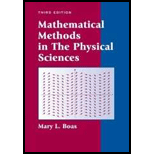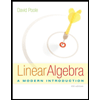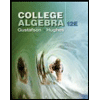
Evaluate the determinants in Problems 1 to 6 by the methods shown in Example 4. Remember that the reason for doing this is not just to get the answer (your computer can give you that) but to learn how to manipulate determinants correctly. Check your answers by computer.
Want to see the full answer?
Check out a sample textbook solution
Chapter 3 Solutions
Mathematical Methods in the Physical Sciences
Additional Math Textbook Solutions
Finite Mathematics for Business, Economics, Life Sciences and Social Sciences
Calculus Volume 2
Introductory Combinatorics
Differential Equations: An Introduction to Modern Methods and Applications
Finite Mathematics & Its Applications (12th Edition)
Mathematics All Around (6th Edition)
- Given the following matrix: B = a b c c d e f g h Let's say that det(A) = −6. Let B be another 3 × 3 matrix (which is not given here) with det(B) = 6. How could you find the determinant of the following matrices? D = 5A^-1B^Tarrow_forwardIf the determinant of a 5×5 matrix A is det(A)=8, and the matrix C is obtained from A by swapping the third and fourth rows, thendet(?)=arrow_forwardIf ∣A∣ = 7 and A is of order 4, then find each determinant.(a) ∣3A∣ (b) ∣AT∣ (c) ∣A−1∣ (d) ∣A3∣arrow_forward
- If the determinant of a 4×4 matrix A is det(A)=−5, and the matrix B is obtained from A by swapping the second and fourth columns, thendet(?)=arrow_forward23.The following problem illustrates a danger that occurs because of round-off error when nearly equal numbers are subtracted and the difference is then multiplied by a large number. Evaluate the quantity 1000⋅∣∣∣6.01018.042.0046.000∣∣∣1000·6.01018.0402.00416.000 in the following ways: a.First round each entry in the determinant to two digits.arrow_forwardQuestion 2 The value of the determinant of the matrix 5A, where A is a square matrix of order 2 and det(A)=3 is 70. - True - Falsearrow_forward
- In parts A and B, evaluate the determinant of the matrix by first reducing the matrix to row echelon form and then using some combination of row operations and cofactor expansionarrow_forwardShow that the elimination method of computing the value of the determinant of an n × n matrix involves [n(n − 1)(2n − 1)]/6 additions and [(n − 1)(n2 + n + 3)]/3 multiplications and divisions. Hint: At the ith step of the reduction process, it takes n − i divisions to calculate the multiples of the ith row that are to be subtracted from the remaining rows below the pivot. We must then calculate new values for the (n − i)2 entries in rows i + 1 through n and columns i + 1 through n.arrow_forward1. Use determinants to find x, y, and z in the below equations:arrow_forward
- Find the determinant of the following matrix. 3 1 0 3 −3 1 2 −1 0arrow_forwardSuppose A is a 5 by 5 matrix. Its entries in row 1 multiply determinants (cofactors) in rows 2-5 to give the determinant. Can you guess a "Jacobi formula" for det A using 2 by 2 determinants from rows 1-2 times 3 by 3 determinants from rows 3-5? Test your formula on the -1, 2, -1 tridiagonal matrix that has determinant= 6.arrow_forward40 - Which of the following is the definition of the determinant of the coefficients of the system of linear equations of order n. a) It is the determinant created by placing the constants on the right side of the system instead of the second column elements in the coefficients determinant. B) It is the determinant formed from the coefficients of the unknowns. NS) It is the determinant created by placing the constants on the right side of the system instead of the fifth column elements in the coefficients determinant. D) It is the determinant created by placing the constants on the right side of the system instead of the first column elements in the coefficients determinant. TO) It is the determinant created by placing the constants on the right side of the system instead of the last column elements in the coefficients determinant.arrow_forward
 Linear Algebra: A Modern IntroductionAlgebraISBN:9781285463247Author:David PoolePublisher:Cengage Learning
Linear Algebra: A Modern IntroductionAlgebraISBN:9781285463247Author:David PoolePublisher:Cengage Learning Algebra for College StudentsAlgebraISBN:9781285195780Author:Jerome E. Kaufmann, Karen L. SchwittersPublisher:Cengage Learning
Algebra for College StudentsAlgebraISBN:9781285195780Author:Jerome E. Kaufmann, Karen L. SchwittersPublisher:Cengage Learning College Algebra (MindTap Course List)AlgebraISBN:9781305652231Author:R. David Gustafson, Jeff HughesPublisher:Cengage Learning
College Algebra (MindTap Course List)AlgebraISBN:9781305652231Author:R. David Gustafson, Jeff HughesPublisher:Cengage Learning


